Validating an Evaporative Calibrator for Gaseous Oxidized Mercury
Abstract
1. Introduction
2. Materials and Methods
2.1. Chemicals and Instruments
- CHgCl2 is the concentration of HgCl2 in the output gas [ng m−3],
- Csol is the concentration of HgCl2 in the calibration solution [ng L−1],
- Qsol is the flowrate of HgCl2 in the calibration solution [mL min−1],
- Qgas is the flowrate of the carrier gas [L min−1],
- Qw is the flowrate of water [L min−1],
- R is the gas constant [J K mol−1],
- T is the temperature [K],
- MH2O is the molar mass of water [kg mol−1],
- p is the pressure [Pa].
2.2. Production of the 197Hg Radiotracer
2.3. Determining 197Hg by Using a HPGe Detector
2.4. Calibrator Time Response Tests
2.4.1. Calibrator Time Response Tests Using HgCl2 Gas
2.4.2. Calibrator Time Response Tests Using HgBr2 Gas
2.5. Hg2+ Species Adsorption Experiments
3. Results and Discussion
3.1. Results Using HgCl2 Gas
3.1.1. Calibrator Time Response Tests
3.1.2. HgCl2 Adsorption
3.1.3. Efforts to Minimize HgCl2 Adsorption
- (a)
- Use of monolithic boron nitride for tubing.
- (b)
- Saturation of adsorption sites.
3.2. Results Using HgBr2 Gas
3.2.1. Calibrator Time Response Tests
3.2.2. HgBr2 Adsorption on the Outside and Inside Tubing of the Calibrator Combined
3.3. Thermodynamics of HgCl2 Adsorption
3.4. Re-Estimation of the Uncertainty Budget for the Calibration Unit
4. Conclusions
Supplementary Materials
Author Contributions
Funding
Institutional Review Board Statement
Informed Consent Statement
Data Availability Statement
Acknowledgments
Conflicts of Interest
References
- UN Environment. Global Mercury Assessment 2018; United Nations Environment Programme: Nairobi, Kenya, 2019. [Google Scholar]
- Lyman, S.N.; Cheng, I.; Gratz, L.E.; Weiss-Penzias, P.; Zhang, L. An updated review of atmospheric mercury. Sci. Total Environ. 2020, 707, 135575. [Google Scholar] [CrossRef]
- Holmes, C.D.; Jacob, D.J.; Mason, R.P.; Jaffe, D.A. Sources and deposition of reactive gaseous mercury in the marine atmosphere. Atmos. Environ. 2009, 43, 2278–2285. [Google Scholar] [CrossRef]
- Ariya, P.A.; Amyot, M.; Dastoor, A.; Deeds, D.; Feinberg, A.; Kos, G.; Poulain, A.; Ryjkov, A.; Semeniuk, K.; Subir, M.; et al. Mercury Physicochemical and Biogeochemical Transformation in the Atmosphere and at Atmospheric Interfaces: A Review and Future Directions. Chem. Rev. 2015, 115, 3760–3802. [Google Scholar] [CrossRef] [PubMed]
- Selin, N.E. Global Biogeochemical Cycling of Mercury: A Review. Annu. Rev. Environ. Resour. 2010, 34, 43–63. [Google Scholar] [CrossRef]
- Gustin, M.S.; Dunham-Cheatham, S.M.; Zhang, L. Comparison of 4 Methos for Measurement of Reactive, Gaseous Oxiize, an Particulate Bound Mercury. Environ. Sci. Technol. 2019, 53, 14489–14495. [Google Scholar] [CrossRef] [PubMed]
- Gustin, M.S.; Dunham-Cheatham, S.M.; Huang, J.; Lindberg, S.; Lyman, S.N. Development of an Understanding of Reactive Mercury in Ambient Air: A Review. Atmosphere 2021, 12, 73. [Google Scholar] [CrossRef]
- Gustin, M.; Jaffe, D. Reducing the uncertainty in measurement and understanding of mercury in the atmosphere. Environ. Sci. Technol. 2010, 44, 2222–2227. [Google Scholar] [CrossRef]
- Gustin, M.S.; Huang, J.; Miller, M.B.; Peterson, C.; Jaffe, D.A.; Ambrose, J.; Finley, B.D.; Lyman, S.N.; Call, K.; Talbot, R.; et al. Do we understand what the mercury speciation instruments are actually measuring? Results of RAMIX. Environ. Sci. Technol. 2013, 47, 7295–7306. [Google Scholar] [CrossRef] [PubMed]
- The International Bureau of Weights and Measures (BIPM). International Vocabulary of Metrology-Basic and General Concepts and Associated Terms (VIM); JCGM 200; Joint Committee for Guides in Metrology: Paris, France, 2012. [Google Scholar]
- Ent, H.; Van Andel, I.; Heemskerk, M.; Van Otterloo, P.; Bavius, W.; Baldan, A.; Horvat, M.; Brown, R.J.C.; Quétel, C.R. A gravimetric approach to providing SI traceability for concentration measurement results of mercury vapor at ambient air levels. Meas. Sci. Technol. 2014, 25, 115801. [Google Scholar] [CrossRef]
- Živković, I.; Berisha, S.; Kotnik, J.; Jagodic, M.; Horvat, M. Traceable determination of atmospheric mercury using iodinated activated carbon traps. Atmosphere 2020, 11, 780. [Google Scholar] [CrossRef]
- Quétel, C.R.; Zampella, M.; Brown, R.J.C.; Ent, H.; Horvat, M.; Paredes, E.; Tunc, M. International system of units traceable results of Hg mass concentration at saturation in air from a newly developed measurement procedure. Anal. Chem. 2014, 86, 7819–7827. [Google Scholar] [CrossRef] [PubMed]
- Quétel, C.R.; Zampella, M.; Brown, R.J.C. Temperature dependence of Hg vapour mass concentration at saturation in air: New SI traceable results between 15 and 30 °C. TrAC-Trends Anal. Chem. 2016, 85, 81–88. [Google Scholar] [CrossRef]
- Long, S.E.; Norris, J.E.; Carney, J.; Ryan, V.; Mitchell, G.D.; Dorko, W.D. Traceability of the output concentration of mercury vapor generators. Atmos. Pollut. Res. 2020, 11, 639–645. [Google Scholar] [CrossRef]
- Srivastava, A.; Hodges, J.T. Development of a High-Resolution Laser Absorption Spectroscopy Method with Application to the Determination of Absolute Concentration of Gaseous Elemental Mercury in Air. Anal. Chem. 2018, 90, 6781–6788. [Google Scholar] [CrossRef]
- Dumarey, R.; Brown, R.J.C.; Corns, W.T.; Brown, A.S.; Stockwell, P.B. Elemental mercury vapour in air: The origins and validation of the “Dumarey equation” describing the mass concentration at saturation. Accredit. Qual. Assur. 2010, 15, 409–414. [Google Scholar] [CrossRef]
- Brown, R.J.C.; Brown, A.S. Accurate calibration of mercury vapour measurements. Analyst 2008, 133, 1611–1618. [Google Scholar] [CrossRef] [PubMed]
- Harvey, A.H. Estimation of the enhancement factor for mercury in air. Int. J. Thermophys. 2010, 31, 297–307. [Google Scholar] [CrossRef]
- Huber, M.L.; Laesecke, A.; Friend, D.G. Correlation for the vapor pressure of mercury. Ind. Eng. Chem. Res. 2006, 45, 7351–7361. [Google Scholar] [CrossRef]
- Ambrose, J.L. Improved methods for signal processing in measurements of mercury by Tekran® 2537A and 2537B instruments. Atmos. Meas. Tech. 2017, 10, 5063–5073. [Google Scholar] [CrossRef]
- Brooks, S.; Ren, X.; Cohen, M.; Luke, W.; Kelley, P.; Artz, R.; Hynes, A.; Landing, W.; Martos, B. Airborne Vertical Profiling of Mercury Speciation near Tullahoma, TN, USA. Atmosphere 2014, 5, 557–574. [Google Scholar] [CrossRef]
- Slemr, F.; Weigelt, A.; Ebinghaus, R.; Kock, H.H.; Bödewadt, J.; Brenninkmeijer, C.A.M.; Rauthe-schöch, A.; Weber, S.; Hermann, M.; Becker, J.; et al. Atmospheric mercury measurements onboard the CARIBIC passenger aircraft. Atmos. Meas. Tech. 2016, 9, 2291–2302. [Google Scholar] [CrossRef]
- Xu, L.; Chen, J.; Yang, L.; Niu, Z.; Tong, L.; Yin, L.; Chen, Y. Chemosphere Characteristics and sources of atmospheric mercury speciation in a coastal city, Xiamen, China. Chemosphere 2015, 119, 530–539. [Google Scholar] [CrossRef] [PubMed]
- Landis, M.S. Development and Characterization of an Annular Denuder Methodology for the Measurement of Divalent Inorganic Reactive Gaseous Mercury in Ambient Air. Environ. Sci. Technol. 2002, 36, 3000–3009. [Google Scholar] [CrossRef] [PubMed]
- Huang, J.; Gustin, M.S. Uncertainties of gaseous oxidized mercury measurements using KCL-coated denuders, cation-exchange membranes, and nylon membranes: Humidity influences. Environ. Sci. Technol. 2015, 49, 6102–6108. [Google Scholar] [CrossRef] [PubMed]
- Huang, J.; Miller, M.B.; Weiss-Penzias, P.; Gustin, M.S. Comparison of gaseous oxidized Hg measured by KCl-coated denuders, and nylon and cation exchange membranes. Environ. Sci. Technol. 2013, 47, 7307–7316. [Google Scholar] [CrossRef]
- Lyman, S.; Jones, C.; O’Neil, T.; Allen, T.; Miller, M.; Gustin, M.S.; Pierce, A.M.; Luke, W.; Ren, X.; Kelley, P. Automated calibration of atmospheric oxidized mercury measurements. Environ. Sci. Technol. 2016, 50, 12911–12927. [Google Scholar] [CrossRef]
- Lyman, S.N.; Gratz, L.E.; Dunham-cheatham, S.M.; Gustin, M.S.; Luippold, A. Improvements to the Accuracy of Atmospheric Oxidized Mercury Measurements. Environ. Sci. Technol. 2020, 54, 13379–13388. [Google Scholar] [CrossRef]
- McClure, C.D.; Jaffe, D.A.; Edgerton, E.S. Evaluation of the KCl denuder method for gaseous oxidized mercury using HgBr2 at an in-service AMNet site. Environ. Sci. Technol. 2014, 48, 11437–11444. [Google Scholar] [CrossRef]
- Schaedlich, F.R.; Schneeberger, D.R. Calibration Gas Delivery Apparatus. U.S. Patent 7,713,742 B2, 11 May 2010. [Google Scholar]
- Dunham, G.; Mibeck, B.; Schulz, R.; Wilmoth, S. Catalyst for Generating Oxidized Mercury for Testing Mercury Continuous Emission Monitors (CEM). U.S. Patent 7,829,047 B2, 8 November 2010. [Google Scholar]
- Saxholm, S.; Rajamäki, T.; Hämäläinen, J.; Hildén, P. Dynamic calibration method for reactive gases. Meas. Sci. Technol. 2020, 31, 034001. [Google Scholar]
- Zhao, S.; Duan, Y.; Chen, L.; Li, Y.; Yao, T.; Liu, S.; Liu, M.; Lu, J. Study on emission of hazardous trace elements in a 350 MW coal-fired power plant. Part 1. Mercury. Environ. Pollut. 2017, 229, 863–870. [Google Scholar] [CrossRef] [PubMed]
- Mlakar, T.L.; Horvat, M.; Vuk, T.; Stergaršek, A.; Kotnik, J.; Tratnik, J.; Fajon, V. Mercury species, mass flows and processes in a cement plant. Fuel 2010, 89, 1936–1945. [Google Scholar] [CrossRef]
- Zhou, H.; Hopke, P.K.; Zhou, C.; Holsen, T.M. Ambient mercury source identification at a New York State urban site: Rochester, NY. Sci. Total Environ. 2019, 650, 1327–1337. [Google Scholar] [CrossRef]
- Castro, M.S.; Moore, C.; Sherwell, J.; Brooks, S.B. Dry deposition of gaseous oxidized mercury in Western Maryland. Sci. Total Environ. 2012, 417–418, 232–240. [Google Scholar] [CrossRef]
- Ambrose, J.L.; Lyman, S.N.; Huang, J.; Gustin, M.S.; Jaffe, D.A. Fast time resolution oxidized mercury measurements during the reno atmospheric mercury intercomparison experiment (RAMIX). Environ. Sci. Technol. 2013, 47, 7285–7294. [Google Scholar] [CrossRef]
- Petrov, P.; Rajamäki, T.; Corns, W.T.; Goenaga-Infante, H. Evaluating the performance of oxidized Hg reference gas generators in the range ng m−3 to μg m−3 by improved coupling with ICP-MS. Atmos. Environ. X 2020, 8, 100090. [Google Scholar]
- Long, S.E.; Norris, J.E.; Carney, J.; Ryan, J.V. Provision of primary NIST traceability to support vapor phase mercury emissions monitoring of combustion sources using isotope dilution inductively coupled plasma mass spectrometry. Atmos. Pollut. Res. 2020, 11, 909–919. [Google Scholar] [CrossRef]
- Lynam, M.M.; Klaue, B.; Keeler, G.J.; Blum, J.D. Using thermal analysis coupled to isotope dilution cold vapor ICP-MS in the quanti fi cation of atmospheric particulate phase mercury. J. Anal. At. Spectrom. 2013, 28, 1788–1795. [Google Scholar] [CrossRef]
- Štrok, M.; Anabelle, P.; Hintelmann, H. Comptes Rendus Geoscience The mercury isotope composition of Arctic coastal seawater. C. R. Geosci. 2015, 347, 368–376. [Google Scholar] [CrossRef]
- Mazur, M.E.E.; Eckley, C.S.; Mitchell, C.P.J. Susceptibility of Soil Bound Mercury to Gaseous Emission As a Function of Source Depth: An Enriched Isotope Tracer Investigation. Environ. Sci. Technol. 2015, 49, 9143–9149. [Google Scholar] [CrossRef]
- Ribeiro Guevara, S.; Jereb, V.; Arribére, M.A.; Pérez Catán, S.; Horvat, M. The production and use of 197Hgg radiotracer to study mercury transformation processes in environmental matrices. RMZ-Mater. Geoenviron. J. 2004, 51, 1928–1931. [Google Scholar]
- Koron, N.; Bratkič, A.; Ribeiro Guevara, S.; Vahčič, M.; Horvat, M. Mercury methylation and reduction potentials in marine water: An improved methodology using 197Hg radiotracer. Appl. Radiat. Isot. 2012, 70, 46–50. [Google Scholar] [CrossRef]
- Žižek, S.; Ribeiro Guevara, S.; Horvat, M. Validation of methodology for determination of the mercury methylation potential in sediments using radiotracers. Anal. Bioanal. Chem. 2008, 390, 2115–2122. [Google Scholar] [CrossRef]
- Ribeiro Guevara, S.; Queimaliños, C.P.; Diéguez, M.d.C.; Arribére, M. Methylmercury production in the water column of an ultraoligotrophic lake of Northern Patagonia, Argentina. Chemosphere 2008, 72, 578–585. [Google Scholar] [CrossRef]
- Ribeiro Guevara, S.; Horvat, M. Stability and behaviour of low level spiked inorganic mercury in natural water samples. Anal. Methods 2013, 5, 1996–2006. [Google Scholar] [CrossRef]
- Shibata, K. Evaluation of neutron nuclear data on mercury isotopes. J. Nuclear Sci. Technol. 2016, 53, 1595–1607. [Google Scholar] [CrossRef][Green Version]
- Ribeiro Guevara, S.; Žižek, S.; Repinc, U.; Catán, S.P.; Jaćimović, R.; Horvat, M. Novel methodology for the study of mercury methylation and reduction in sediments and water using 197Hg radiotracer. Anal. Bioanal. Chem. 2007, 387, 2185–2197. [Google Scholar] [CrossRef]
- Akagi, H. Analytical methods for evaluating human exposure to mercury due to gold mining. In Proceedings of the Health and Environmental Effects of Mercury due to Mining Operations, Manila, Philipines, 26–27 November 1997; pp. 131–141. [Google Scholar]
- Wang, S.; Zhang, L.; Wu, Y. Mercury emission and speciation of coal-fired power plants in China. Atmos. Chem. Phys. 2010, 10, 1183–1192. [Google Scholar] [CrossRef]
- Kho, F.; Pham, G.H. Absorption kinetics of mercury (II) chloride into water and aqueous sodium chloride solution. Fuel Process. Technol. 2018, 174, 78–87. [Google Scholar] [CrossRef]
- Ciavatta, L.; Grimaldi, M. Equilibrium Constants of Mercury (II) Chloride Complexes. J. Inorg. Nucl. Chem. 1968, 30, 197–205. [Google Scholar] [CrossRef]
- Kozin, L.F.; Hansen, S.C. Mercury Handbook: Chemistry, Applications and Environmental Impact; Guminski, C., Ed.; Royal Society of Chemisty: Cambridge, UK, 2013; ISBN 9781849734097. [Google Scholar]
- Sabri, Y.M.; Ippolito, S.J.; Tardio, J.; Morrison, P.D.; Bhargava, S.K. Studying mercury partition in monoethylene glycol (MEG) used in gas facilities. Fuel 2015, 159, 917–924. [Google Scholar] [CrossRef]
- Bernard, S.; Salameh, C.; Miele, P. Boron nitride ceramics from molecular precursors: Synthesis, properties and applications. Dalton Trans. 2016, 45, 861–873. [Google Scholar] [CrossRef]
- Hepler, L.G.; Olofsson, G. Mercury: Thermodynamic Properties, Chemical Equilibria, and Standard Potentials. Chem. Rev. 1975, 75, 585–602. [Google Scholar] [CrossRef]
- Lyubchik, S.; Lyubchik, A.; Lygina, O.; Lyubchik, S.; Fonsec, I. Comparison of the Thermodynamic Parameters Estimation for the Adsorption Process of the Metals from Liquid Phase on Activated Carbons. In Thermodynamics-Interaction Studies-Solids, Liquids and Gases; Moreno-Piraján, J.C., Ed.; IntechOpen: London, UK, 2011. [Google Scholar]
- Musmarra, D.; Karatza, D.; Lancia, A.; Prisciandaro, M.; Di Celso, G.M. A comparison among different sorbents for mercury adsorption from flue gas. Chem. Eng. Trans. 2015, 43, 2461–2466. [Google Scholar]
- Lin, H.Y.; Yuan, C.S.; Chen, W.C.; Hung, C.H. Determination of the adsorption isotherm of vapor-phase mercury chloride on powdered activated carbon using thermogravimetric analysis. J. Air Waste Manag. Assoc. 2006, 56, 1550–1557. [Google Scholar] [CrossRef]
- Ie, I.R.; Chen, W.C.; Yuan, C.S.; Hung, C.H.; Lin, Y.C.; Tsai, H.H.; Jen, Y.S. Enhancing the adsorption of vapor-phase mercury chloride with an innovative composite sulfur-impregnated activated carbon. J. Hazard. Mater. 2012, 217–218, 43–50. [Google Scholar] [CrossRef] [PubMed]
- Ghosal, P.S.; Gupta, A.K. Determination of thermodynamic parameters from Langmuir isotherm constant-revisited. J. Mol. Liq. 2017, 225, 137–146. [Google Scholar] [CrossRef]
- Mananghaya, M.; Yu, D.; Santos, G.N.; Rodulfo, E. Adsorption of mercury(II) chloride and carbon dioxide on graphene/calcium oxide (0 0 1). Korean J. Mater. Res. 2016, 26, 298–305. [Google Scholar] [CrossRef]
- The International Bureau of Weights and Measures (BIPM). Evaluation of Measurement Data-Guide to the Expression of Uncertainty in Measurement; JCGM 100; Joint Committee for Guides in Metrology (JCGM): Paris, France, 2008. [Google Scholar]
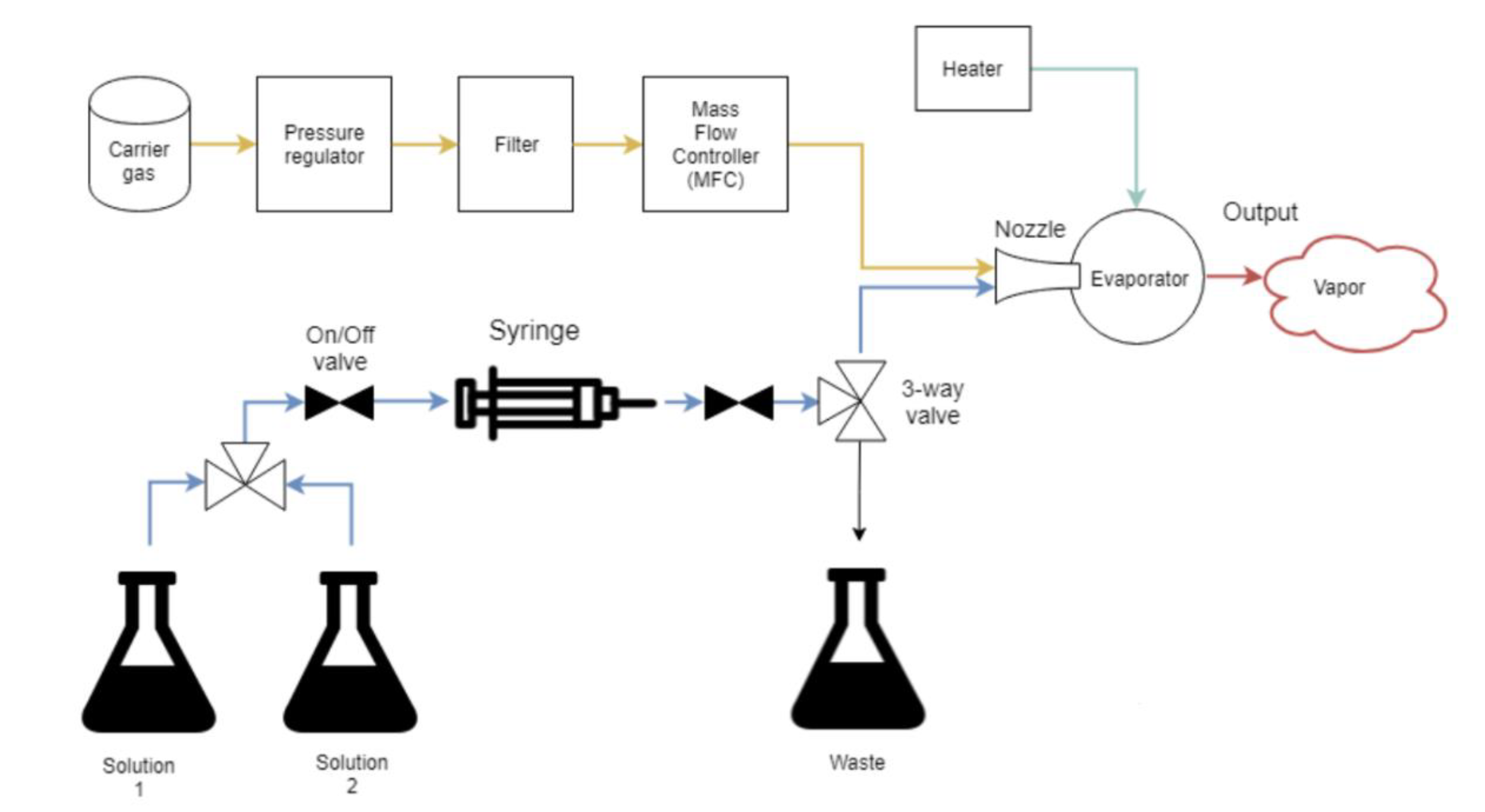
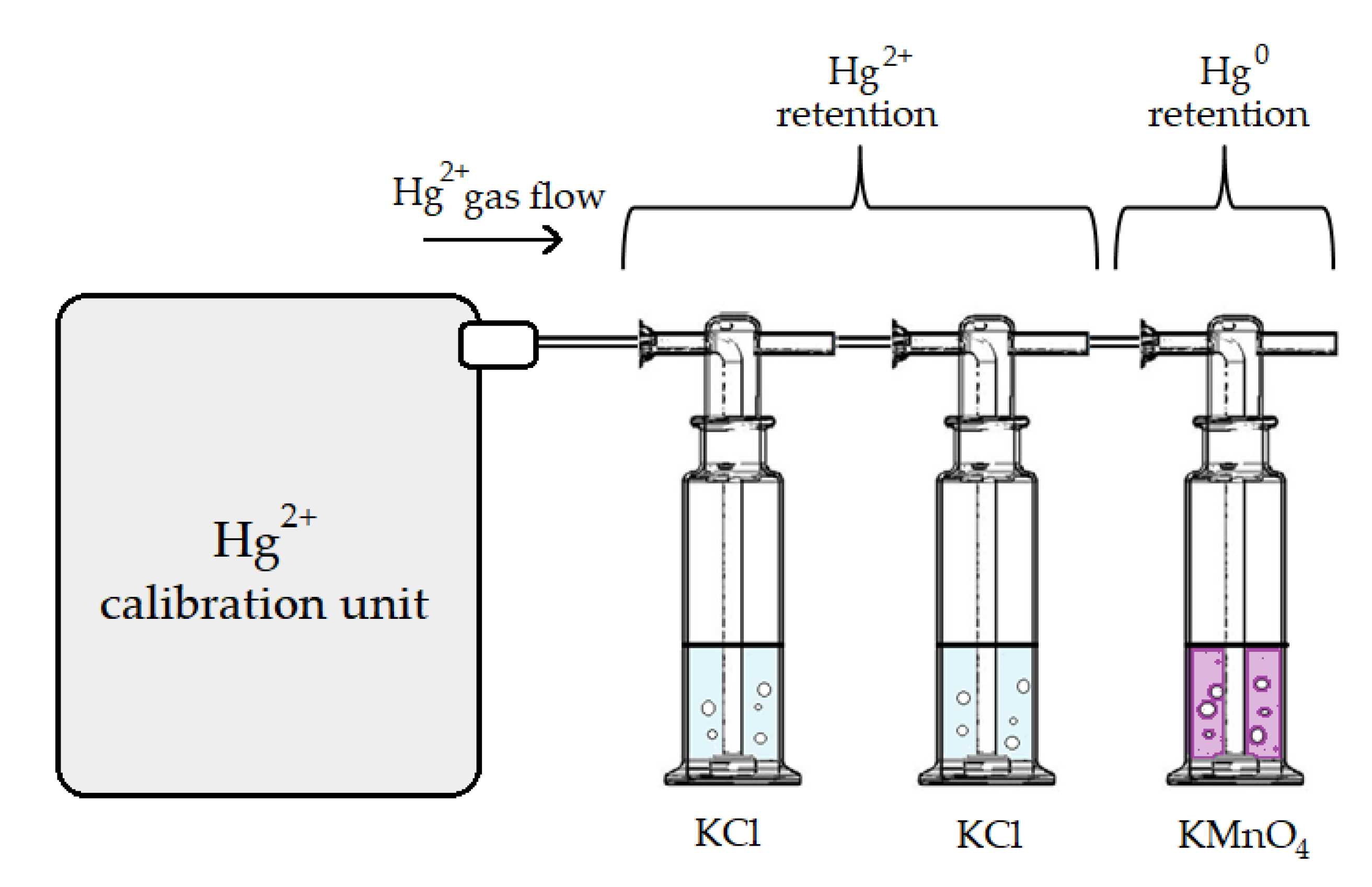
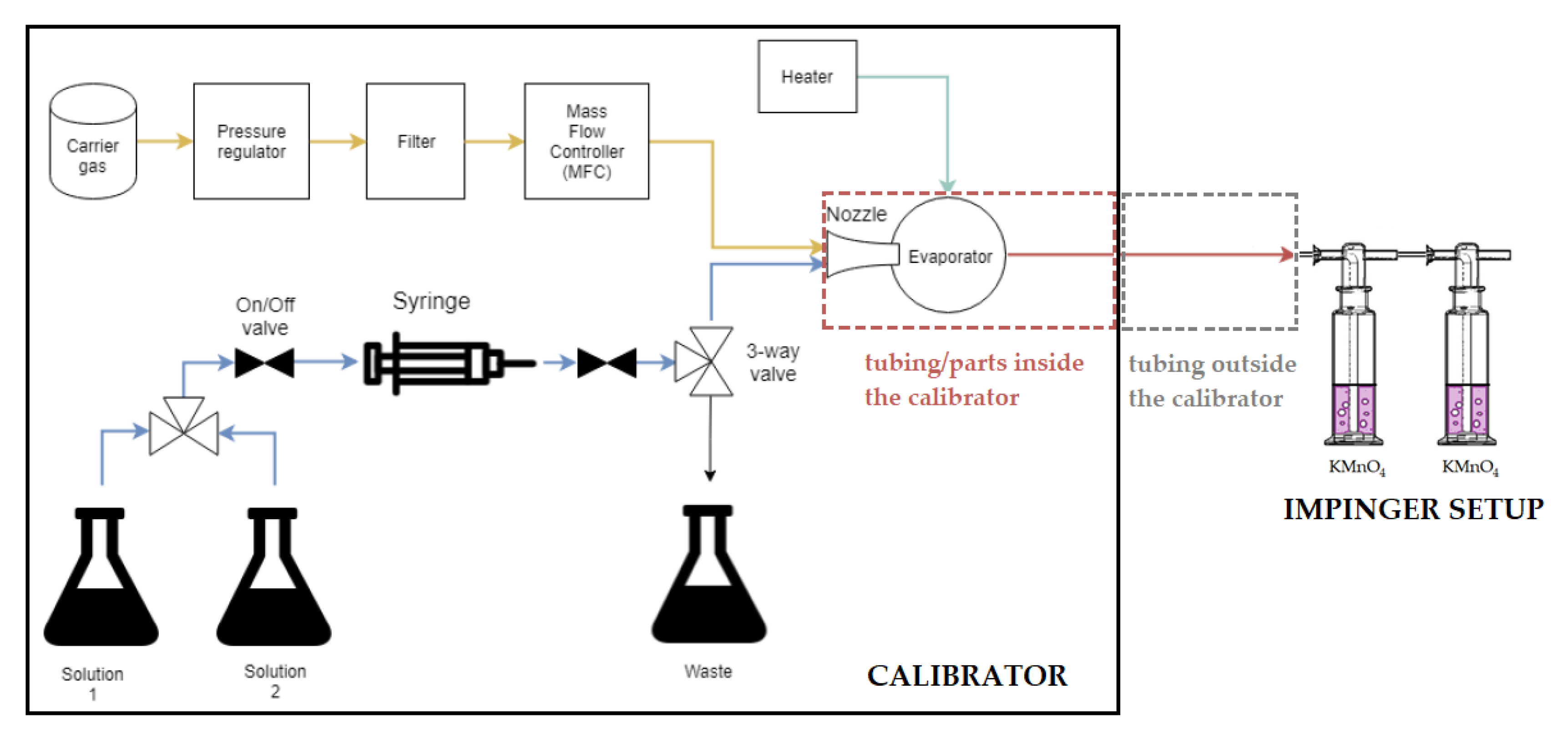
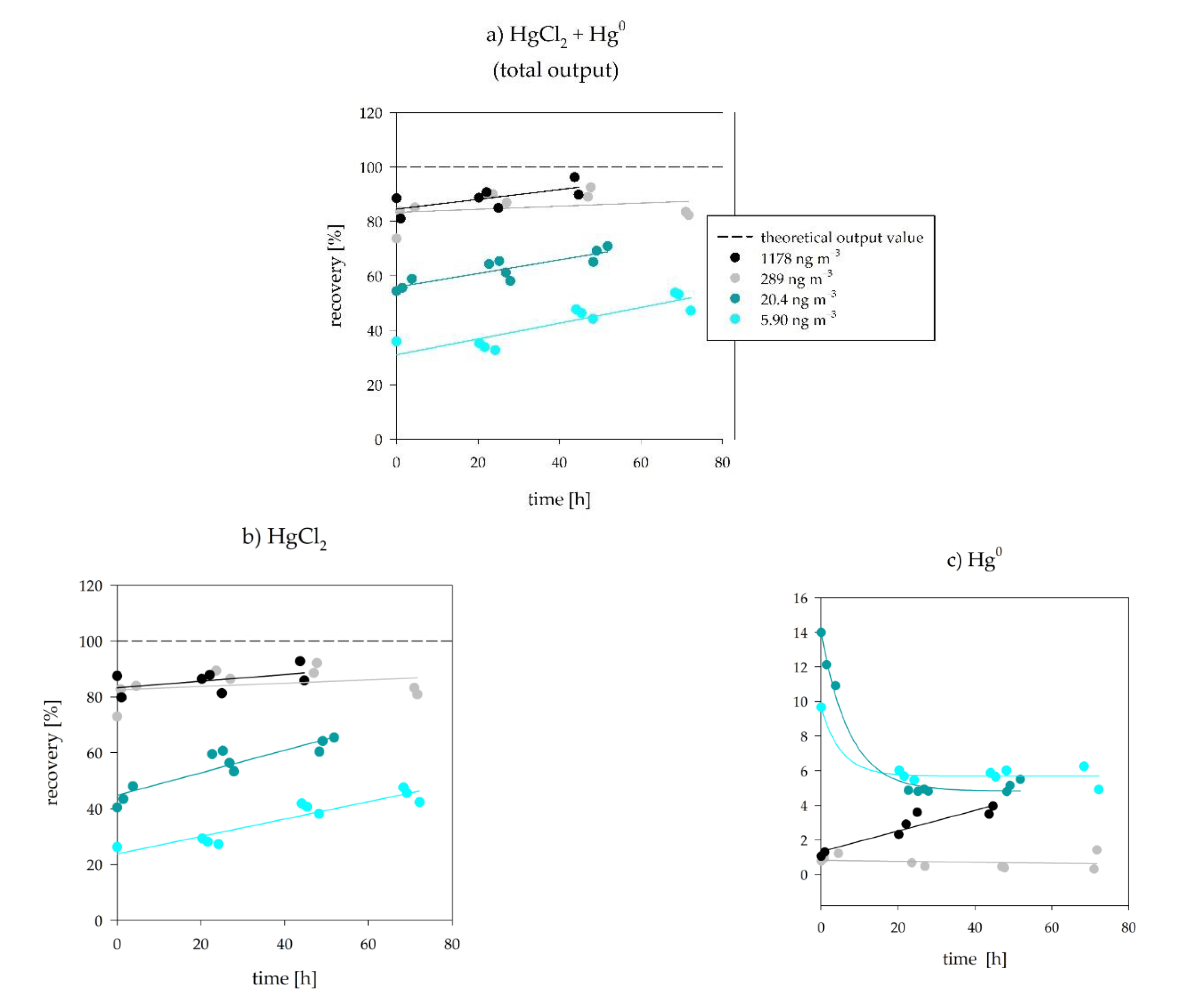
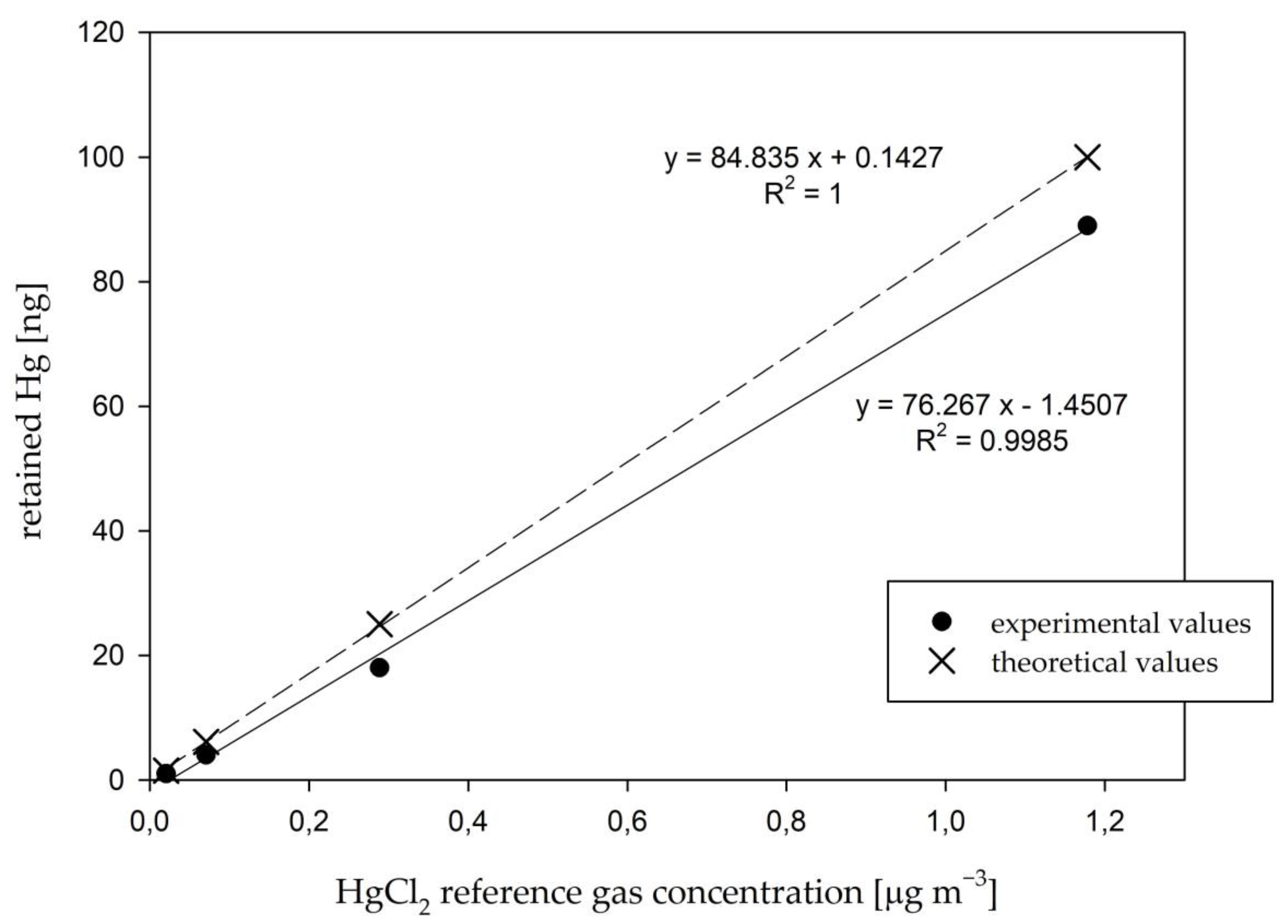
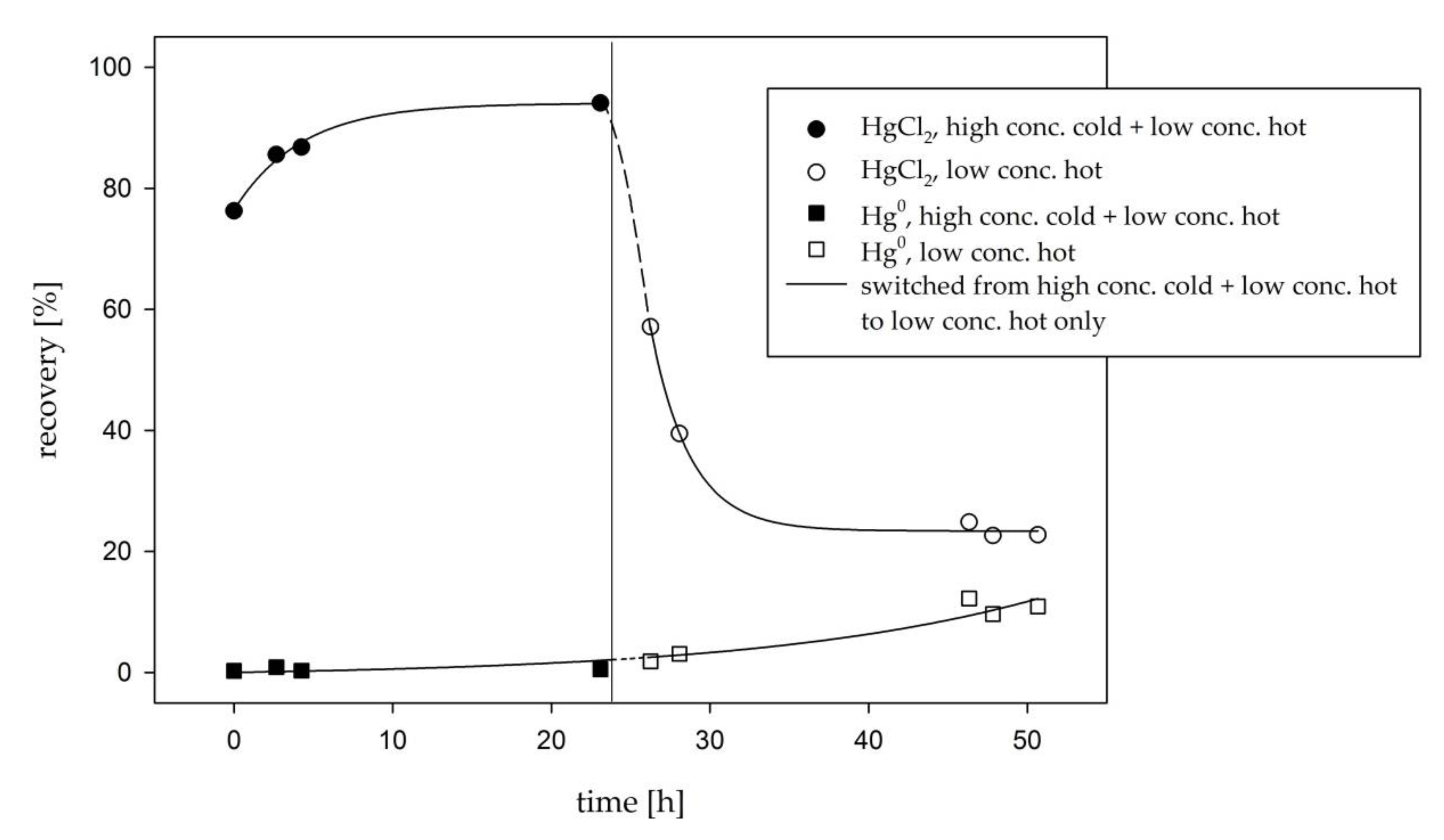
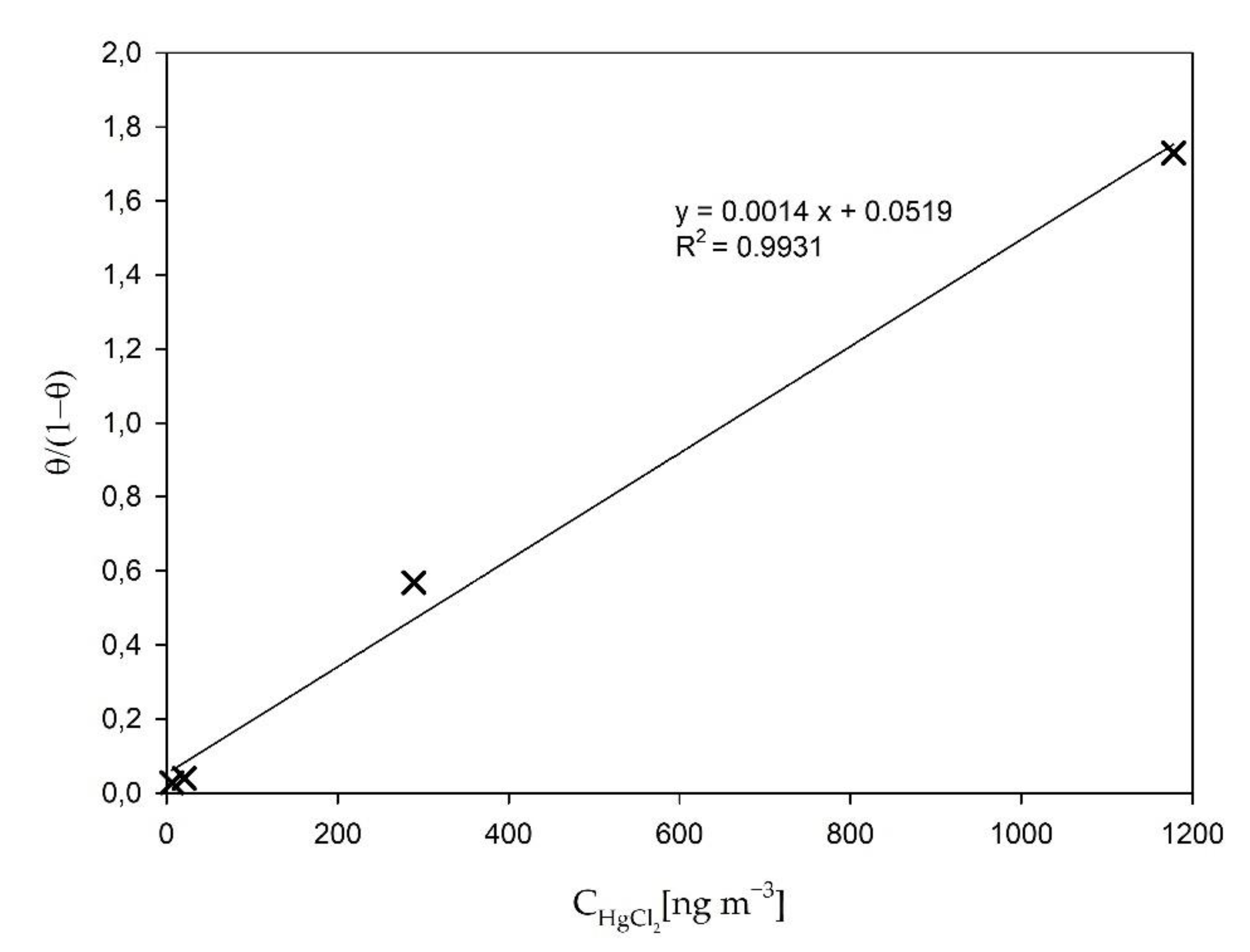
| Authors | Principle of Operation | Species | Concentration Level |
|---|---|---|---|
| Lyman et al. [28] | permeation | HgCl2/HgBr2 | <1 ng m−3 |
| McClure et al. [30] | HgBr2 | 1 ng m−3 | |
| Schaedllich et al. [31] (Hovacal®, IAS GmbH) | liquid evaporation | HgCl2 | N/A, used mostly for > 1 µg m−3 |
| Saxholm et al. [33] (Optoseven Ltd. & VTT Ltd.) | HgCl2/HgBr2 (not yet tested) | >1 µg m−3, potential for ng m−3 levels |
| Tubing Inside the Calibrator [%] | Tubing Outside the Calibrator [%] | Two-Impinger Setup [%] | Sum [%] | |
|---|---|---|---|---|
| replicates | 13.2 | 41.6 | 46.1 | 101 |
| 16.3 | 45.5 | 43.6 | 105 | |
| average | 14.7 | 43.6 | 44.8 | 103 |
| HgCl2 Gas Concentration | Temperature of the Calibrator Evaporation Chamber [°C] | Tubing Outside the Calibrator [%] | Two-Impinger Setup [%] | Sum [%] |
|---|---|---|---|---|
| 70.7 ng m−3 | 125 | 47.1 | 43.7 | 90.7 |
| 43.1 | 35.4 | 78.5 | ||
| 180 | 18.8 | 61.8 | 80.6 | |
| 1178 ng m−3 | 125 | 16.9 | 63.1 | 80.1 |
| 15.8 | 76.9 | 92.8 | ||
| 180 | 16.3 | 74.3 | 90.6 | |
| 17.1 | 73.6 | 90.7 |
| HgBr2 Gas Concentration | Time [h] | KCl 1 [%] | KCl 2 [%] | KMnO4 [%] | Sum [%] |
|---|---|---|---|---|---|
| 70.7 ng m−3 | 0 | 9.55 | 0.05 | 0.27 | 9.87 |
| 1.50 | 10.3 | 0.42 | 0.12 | 10.8 | |
| 3.66 | 11.8 | 0.07 | 0.62 | 12.5 | |
| 1178 ng m−3 | 0 | 18.7 | 3.29 | 2.01 | 24.0 |
| 1 | 27.4 | 0.07 | 1.97 | 29.5 | |
| 3 | 26.3 | 0.55 | 2.22 | 29.1 |
Publisher’s Note: MDPI stays neutral with regard to jurisdictional claims in published maps and institutional affiliations. |
© 2021 by the authors. Licensee MDPI, Basel, Switzerland. This article is an open access article distributed under the terms and conditions of the Creative Commons Attribution (CC BY) license (https://creativecommons.org/licenses/by/4.0/).
Share and Cite
Gačnik, J.; Živković, I.; Ribeiro Guevara, S.; Jaćimović, R.; Kotnik, J.; Horvat, M. Validating an Evaporative Calibrator for Gaseous Oxidized Mercury. Sensors 2021, 21, 2501. https://doi.org/10.3390/s21072501
Gačnik J, Živković I, Ribeiro Guevara S, Jaćimović R, Kotnik J, Horvat M. Validating an Evaporative Calibrator for Gaseous Oxidized Mercury. Sensors. 2021; 21(7):2501. https://doi.org/10.3390/s21072501
Chicago/Turabian StyleGačnik, Jan, Igor Živković, Sergio Ribeiro Guevara, Radojko Jaćimović, Jože Kotnik, and Milena Horvat. 2021. "Validating an Evaporative Calibrator for Gaseous Oxidized Mercury" Sensors 21, no. 7: 2501. https://doi.org/10.3390/s21072501
APA StyleGačnik, J., Živković, I., Ribeiro Guevara, S., Jaćimović, R., Kotnik, J., & Horvat, M. (2021). Validating an Evaporative Calibrator for Gaseous Oxidized Mercury. Sensors, 21(7), 2501. https://doi.org/10.3390/s21072501







